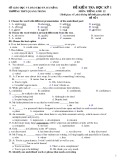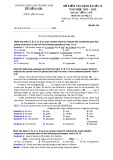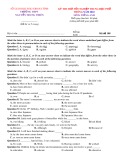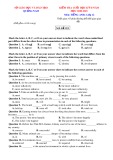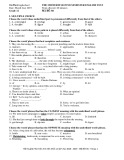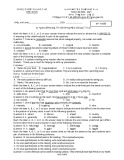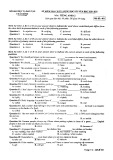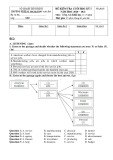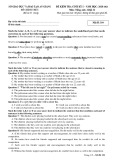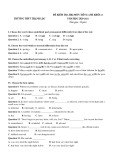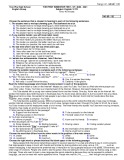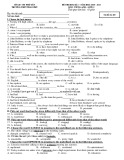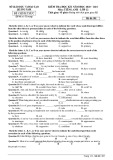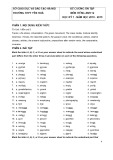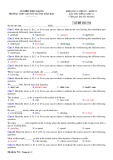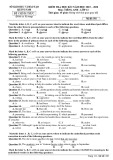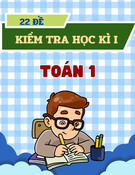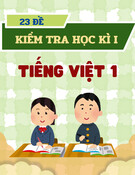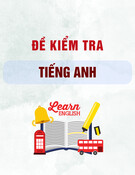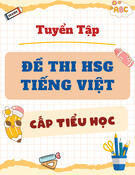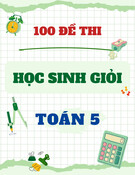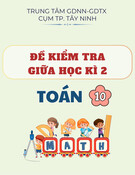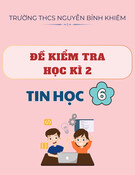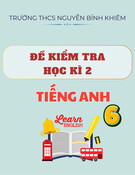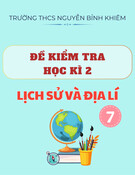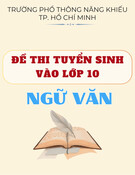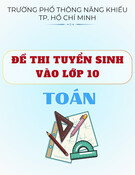SỞ GD&ĐT CÀ MAU KIỂM TRA 1 TIẾT LẦN 2 - NĂM HỌC 2017 - 2018
TRƯỜNG THPT PHAN NGỌC HIỂN MÔN TIẾNG ANH
Thời gian làm bài: 45 Phút; (Đề có 40 câu)
Mã đề 123
Câu 1: Who ……………to on the phone as we came into the room?
A. had you talked. B. did you talk.
C. were you talking. D. have you been talking.
Câu 2: Mary tried on a dress and then bought it.
A. Before going a trial test, Mary bought a new dress.
B. Mary bought the dress after she had tried on.
C. Mary was tired of her dress so she bought a new one.
D. After she bought the dress, she tried it on.
Câu 3: A/an ……………. is an official document stating that you have passed an examination, completed a course, or achieved some necessary qualifications.
A. requirement. B. test. C. certificate. D. education.
Câu 4: It ……………dark. Shall I turn on the light?
A. got. B. get. C. has got. D. is getting.
Câu 5: Choose the mistake of the sentence.
Antarctic blue whales can be 100 foot long and weigh more than any dinosaur that ever lived.
A. more than any. B. blue whales. C. ever. D. 100 foot long.
Câu 6: My Dad is always willing to give a hand ………… cleaning the house.
A. in. B. with. C. of. D. about.
Câu 7: My parents don’t put pressure on me to make ………. about what to study at university.
A. a choice. B. a decision. C. a reply. D. a determination.
Câu 8: Brown was last seen in July 1928.
A. No one saw Brown until July 1928.
B. Brown has not been able to see since July 1928.
C. Brown didn’t see anyone in July 1928.
D. No one has seen Brown since July 1928.
Câu 9: Peter is a ……….……. boy. He usually plays tricks on the others.
A. caring. B. generous. C. mischievous. D. helpful.
Câu 10: The owner invited the guest:
The owner: - “Would you like a chocolate?”
The guest: - “…………………..”
A. No, thanks. I am on a diet. B. No, please.
C. I want. D. I like.
Câu 11: She said she ………………….
A. had been very tired last night. B. had been very tired the night before.
C. was very tired last night. D. was very tired the night before.
Câu 12: Ted and Amy …………..for 24 years.
A. were married. B. married.
C. has been married. D. have been married.
Câu 13: In the 1960s, Vietnamese parents often didn’t ……….their children choose their wife or husband.
A. allow. B. want. C. permit. D. let.
Câu 14: A good partner is the one in whom you can … ………..
A. love. B. share. C. live. D. confide.
Câu 15: .………………you go to the dentist?
A. How often are. B. How often do. C. How are. D. How often does.
Câu 16: Portuguese …………… as an official language in this city since three hundred years ago.
A. always spoken. B. has been spoken always.
C. has always been spoken. D. has always spoken.
Câu 17: When you are in a restaurant, you can raise your hand slightly to show that you need assistance.
A. bill. B. food. C. help. D. menu.
Câu 18: I am very …………..…in the information you have given me.
A. concerned. B. surprised. C. interesting. D. interested.
Câu 19: Choose the mistake of the sentence.
Some people who are a great deal heavier than they should be persuaded them that they are “just right”.
A. them. B. some people. C. a great deal. D. should be.
Câu 20: Brenda asked Carol:
Brenda: “Do you think it will rain?” - Carol: “Oh! …………”.
A. I hope not. B. I don’t hope. C. It’s hopeless. D. I don’t hope so.
Câu 21: Mark the letter A, B, C or D to indicate the word that differs from the other three in the position of primary stress in each of the following questions.
A. informality. B. situation. C. entertainment. D. appropriate.
Câu 22: Mark the letter A, B, C or D to indicate the word that differs from the other three in the position of primary stress in each of the following questions.
A. generally. B. responsible. C. obedient. D. biologist.
Câu 23: A passenger is talking to a staff at the airport:
Passenger: - “Has an announcement been made about the 8 o’clock- flight to Paris?”
Staff: - “…………………”
A. Yes, it is. B. I don’t think that. C. Not yet. D. Sorry, I don’t.
Câu 24: Mark the letter A, B, C or D to indicate the word whose underlined part differs from the other three in pronunciation in each of the following questions
A. jokes. B. dates. C. names. D. photographs.
Câu 25: Mary and Rose are talking to each other:
Mary: - “You look great in this new dress.”
Rose - ”…………………….”.
A. I am glad you like it. B. With pleasure.
C. Not at all. D. Do not say anything about it.
Câu 26: My brother hasn’t drunk beer for 2 years.
A. My brother stopped to drink beer 2 years ago.
B. My brother enjoyed drinking beer 2 years ago.
C. My brother began drinking beer 2 years ago.
D. My brother gave up drinking beer 2 years ago.
Câu 27: Emily said that her teacher ……………. to London ………………. .
A. would go / the next day. B. went / tomorrow.
C. had gone / the next day. D. will go / tomorrow.
Câu 28: Mark the letter A, B, C or D to indicate the word whose underlined part differs from the other three in pronunciation in each of the following questions.
A. rejected. B. conducted. C. concerned. D. confided.
Câu 29: The academic year in Vietnam is over ………… the end ………….. May.
A. from / in. B. at / of. C. for / on. D. on / in.
Câu 30: “You damage my laptop, Mike,” said Sylvia.
A. Sylvia said Mike has damaged her laptop. B. B. Sylvia accused Mike of damaging her laptop.
C. Sylvia told Mike to damage her laptop.
D. Sylvia threatened Mike to damage her laptop.
Read the following passage and mark the letter A, B, C or D to indicate the correct word or phrase that best fits each of the numbered blanks.
Every year, thousands of people travel to Britain in order to improve their standard of English. For many, however, this can be a (31) ………. experience due to the fact that it involves attending a strange school, staying in sometimes unpleasant accommodation and living in an unfamiliar culture. One (32) ………. to these problems is the Homestay method. With this, students are each assigned a teacher suited to their language requirements and interests. As well as giving individual tuition, the teacher provides the student (33) ……….. information about what activities are available locally and takes them on trips. Students get between ten and twenty hours of tuition a week and are also (34) ………. to join in the family’s daily activities. The students speak English at all times and therefore learn how to use the language in everyday situations. Homestay programmes usually (35) ………. for up to four weeks. Although costs are higher than of regular language schools, students can feel confident that they will be receiving top-class language teaching in a safe and pleasant environment.
Câu 31. A. sore B. aching C. sick D. painful
Câu 32. A. requirement B. answer C. argument D. reaction
Câu 33. A. for B. of C. with D. into
Câu 34. A. expected B. forced C. desired D. wished
Câu 35. A. pass B. stay C. remain D. last
Read the following passage and mark the letter A, B, C or D to indicate the correct answer to each of the questions.
Improving girls’ educational levels has been demonstrated to have clear impacts on the health and economic future of young women, which in turn improves the prospects to their entire community. The infant mortality rate of babies whose mothers have received primary education is half that of children whose mothers are illiterate. In the poorest countries of the world, 50% of girls do not attend secondary school. Yet, reseach shows that every extra year of school for girls increases their lifetime income by 15%. Improving female education, and thus the earning potential of women, improves the standard of living for their own children, as women invest more of their income in their families than men do. Yet, manybarriers to education for girls remain. In some African countries, such as Burkina Faso, girls are unlikely to attend school for such basic reasons as a lack of private toilet facilities for girls.
Higher attendance rates of high schools and university education among women, particularly in developing countries, have helped them make inroads into professional careers with better – paying salaries and wages. Education increases a woman’s (and her partner and the family’s) level of health and health awareness. Furthering women’s levels of education and advanced training also tends to lead to later ages of initiation of sexual activity, later age at first marriage, and later age at first childbirth, as well as an increased likelihood to remain single, have no children, or have no formal marriage and alternatively, have increasing leavels of long- term partnerships. It can lead to higher rates of barrier and chemical contraceptive use (and a lower level of sexually transmitted infections among women and their partners and children), and can increase the level of resources available to women who divorce or are in a situation of domestic violence. It has been shown, in addition, to increase women’s communication with their partners and their employers, and to improve rates of civic participation such as voting or the holding of office.
Câu 36. It is started in the first paragraph that ……………….. .
A. women’s educational levels have influence on the prospect of their community
B. women who have little schooling often have no idea of raising their children
C. it is the children’s schooling that helps their mothers increase their lifetime income
D. earning their own living, women take the responsibilty of running the household
Câu 37. It is implied in the first paragraph that …………….. .
A. the husband in a family takes little responsibility in rearing the children
B. the mother in a family makes every effort to raise the children effectively
C. the children’s standard of living largely depends on their mother’s income
D. there are numerous reasons for women not to come to class worldwide
Câu 38. The word “barriers” in the passage is closest in meaning to …………… .
A. challenges B. problems C. difficulties D. limits
Câu 39. The word “It” in the passage refers to …………… .
A. furthering women’s levels of education and advanced training
B. higher attendance rates of high schools and university education
C. increasing levels of long-term partnerships
D. a woman’s level of health and health awareness
Câu 40. What can be the best title of the reading passage?
A. Education and Women’s Empowerment
B. Female Education and its Social Benefits
C. Women’s Rights to Lifelong Education
D. Education and Violence Against Women
……..THE END……
Câu 123 224 322 425
1 C A B C
2 B C A A
3 C C A B
4 D C A A
5 D B A A
6 B C B B
7 B A D B
8 D B B B
9 C A C A
10 A C B D
11 B C B D
12 D B B A
13 D A D D
14 D C C A
15 B A B C
16 C C B D
17 C C C A
18 D D B C
19 A A C A
20 A A D B
21 D B B D
22 C A B D
23 C C C D
24 C B C C
25 A B A B
26 D D D D
27 A C B C
28 C C C D
29 B D C B
30 B C C C
31 D D D D
32 B B B B
33 C C C C
34 A A A A
35 D D D D
36 A A A A
37 D D D D
38 C C C C
39 A A A A
40 B B B B

